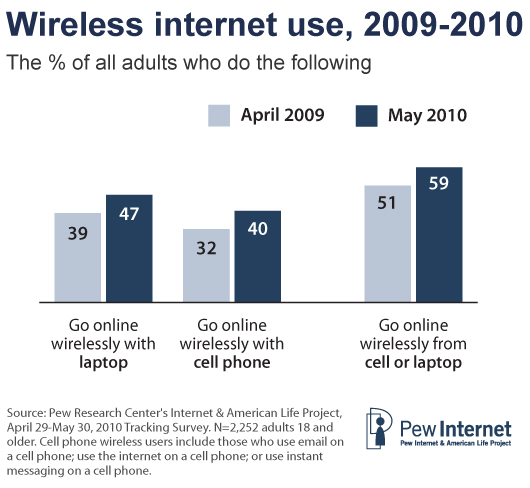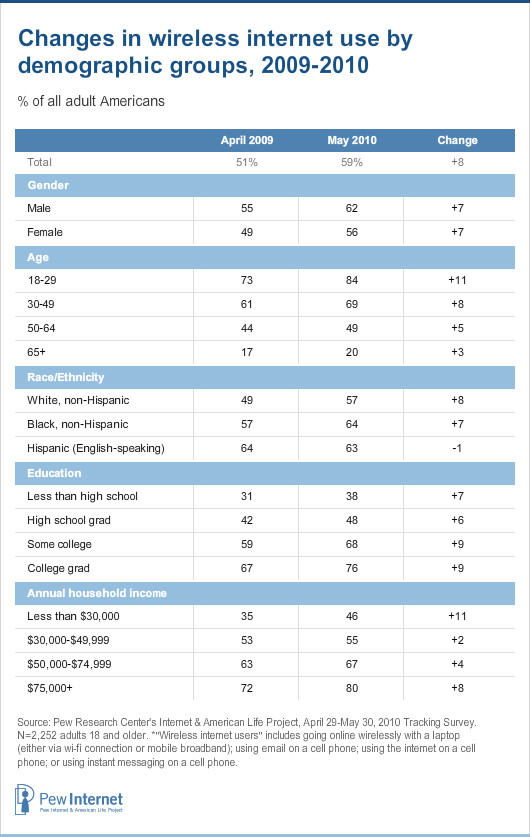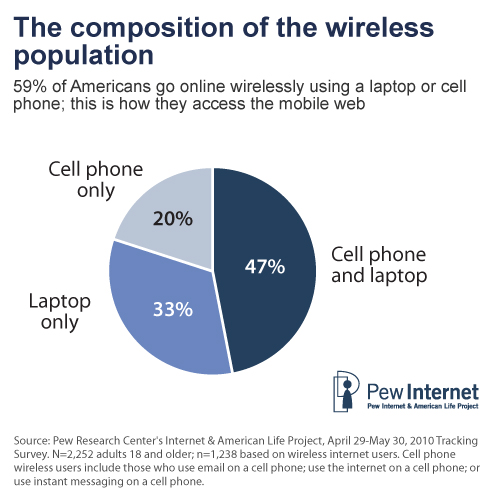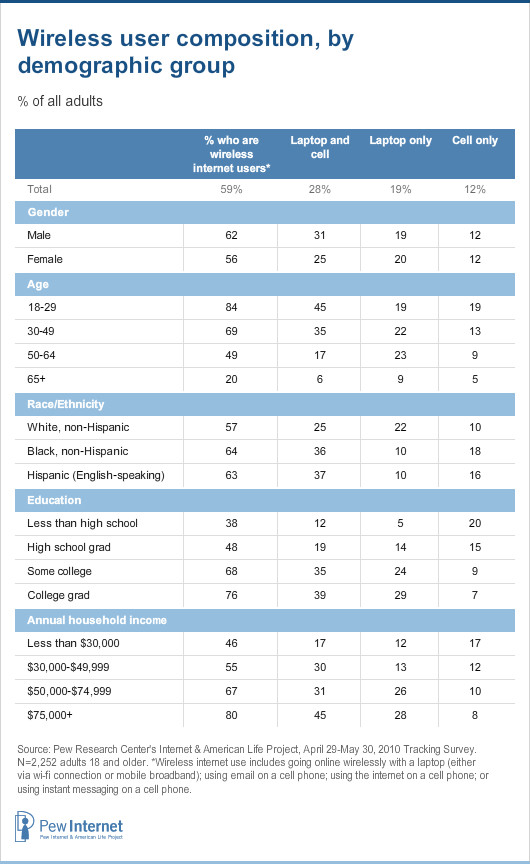The current state of wireless internet use
As of May 2010, six in ten American adults (59%) are wireless internet users. Due to the quickly evolving nature of mobile technologies, our definition of a wireless internet user has changed several times since we began studying this topic; throughout this report, a wireless internet user is defined as someone who does one or more of the following:
- Go online from a laptop using a wi-fi or mobile broadband internet connection. 86% of laptop owners go online in this way, which represents 47% of all American adults.
- Use the internet, email or instant messaging from a cell phone. Half (49%) of cell phone owners do at least one of these on their mobile device, which works out to 40% of all adults.
The 59% of American adults who do at least one of these activities represents an eight-point increase over the 51% of American adults who did so in our April 2009 wireless internet survey, and wireless access using both cell phones and laptops has grown significantly on a year-to-year basis.1 The remaining 41% of Americans includes those who are internet users but do not go online wirelessly (22%) as well as those who are not internet users (19%).

Laptop computers and cell phones are the primary way Americans go online wirelessly. When we include other devices (such as mp3 players, e-book readers or tablet computers) in our definition of wireless internet usage, total usage increases by just one half of one percentage point. These other devices will be discussed individually in more detail in Part Three — Mobile Access Using Laptops and Other Devices.
This eight point year-to-year increase in wireless internet usage is reflected across a fairly broad range of demographic groups, with 18-29 year olds and those with a household income of less than $30,000 per year showing the greatest increases on a percentage point basis. Wireless internet usage remained flat for only a small number of groups, such as Latinos and those older than 50—although in contrast to older Americans, Latinos continue to have high overall rates of wireless adoption. In interpreting these figures, it is important to keep in mind that our survey did not provide a Spanish-language option so all data for Hispanics represents English-speaking Hispanics only.2
These higher rates of growth in wireless internet use by whites and African-Americans compared with Latinos are largely a function of laptop adoption. Rates of laptop ownership have grown dramatically among African-Americans in the last year (from 34% in 2009 to 51% in 2010) and moderately among whites (from 47% to 55%). By contrast, laptop ownership among English-speaking Latinos has remained flat over that time (54% of Latinos currently own a laptop computer, compared with 56% who did so in 2009).

Wireless internet users are evenly split between those who access the internet wirelessly using only one device (a total of 53% of wireless users go online using either a cell phone or a laptop, but not both) and those who do so using both a laptop and a mobile phone (47% of wireless users). Additionally, many wireless users take advantage of stationary technologies—70% of wireless internet users own a desktop computer, and 57% own a home gaming console such as an Xbox or PlayStation.

Several groups have relatively high rates of cell phone internet use. Some of these include:
- African-Americans and Latinos – 18% of blacks and 16% of English-speaking Hispanics are cell-only wireless users, compared with 10% of whites. In total, roughly half of African-Americans (54%) and Hispanics (53%) go online from a mobile phone.
- Young adults – 19% of 18-29 year olds are cell-only wireless users, compared with 13% of 30-49 year olds, 9% of 50-64 year olds and 5% of those ages 65 and older. In total, two-thirds of 18-29 year olds (65%) are cell phone internet users and 84% go online using either a cell phone or a laptop with a wireless internet connection.
- Those with low levels of income and education – 17% of those earning less than $30,000 per year are cell-only wireless users, as are 20% of those who have not graduated from high school and 15% of those who have graduated high school but have not attended college. The affluent and well-educated have higher overall levels of wireless internet use due to their much higher rates of ownership and use of laptop computers.
Seniors are currently the group with the lowest levels of wireless internet usage. Eight in ten seniors (those ages 65 and older) are either internet users who do not go online wirelessly (24%) or not online at all (56%).

In the rest of this report, we will take a more detailed examination of wireless access using mobile phones (Part Two: Internet use and data applications using mobile phones) and laptop computers and other devices (Part Three: Mobile access using laptops and other devices).




